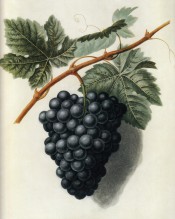Vitis vinifera ‘Black Hamburgh’
‘Bunches tolerably large, with two short compact shoulders, nearly as broad across as the bunch is deep. Berries pretty large, of an oval figure, but when grown to an extraordinary size, they are much enlarged at the head. Skin rather thick, of a deep purple colour, nearly black, and covered with a blue bloom. Flesh tender. Juice sugary, and well-flavoured.’ [George Lindley – Orchard Guide p.192/1831].
Horticultural & Botanical History
‘This very valuable grape was brought into England by Mr. Warner, who had his garden at Rotherhithe in 1724. Hence it is sometimes called the Warner Grape. It is a great bearer, and its bunches, although not large, are always perfect, and regularly formed. In the autumn the leaves are mottled with green and yellow.’ [George Lindley – Orchard Guide p.193/1831].
‘Black Hamburg is a variety of Vitis vinifera, impossible to grow out of doors in eastern America, but illustrated and described here because it is one of the parents of many hybrids with American species and because it represents, in fruit characters at least, about all that is desirable in a good grape. Since it is a standard of excellence which American breeders of table grapes have long sought to attain, we may name its points of superiority over the table grapes now grown in our vineyards. 1st. Bunch and berry are large, well formed, and uniform. 2nd. The fruits have a higher sugar and solid content than most American grapes and keep better, ship better, make better wine and will make raisins. 3d. The flavor, to most palates, is richer, more delicate, and lacks the acidity of some American grapes and the foxiness of others. 4th. The pulp and skin of Black Hamburg are more tender than the varieties of the species of this country and the seeds are readily separated from the pulp. 5th. The berries do not shell from the stem readily. 6th. The vines are more compact in habit, make a shorter and stouter annual growth, and hence require less pruning and training. 7th. The fruit is borne in greater quantity, vine for vine or acre for acre. Added to the above qualities which make it desirable as a parent when crosses are made between the grapes of this countrvy and Vitis vinifera, are comparative hardiness among its kind, a short seasonal cycle of vegetation giving early maturity to fruit, ability to stand more hardships than most of its species, and especially ability to mature its fruit with as small amount of solar heat as any of its species. Its weaknesses when planted out of doors in eastern America are those of its species, which wholly prevent its successful cultivation in the vineyards of this region and make it of interest and value only in breeding and as an ideal toward which to breed.
The origin of Black Hamburg is apparently unknown. It was sent from Hamburg, Germany, to England sometime in the early part of the eighteenth century and it was in the latter country that it was given the several variations of the name Hamburg. In the north of Europe it is known as Frankendale or Frankenthal. Black Hamburg is grown in Europe chiefly as a forcing grape. It is doubtful if all the synonyms refer to one seed variety, but if not the same, they are so similar as to be difficult if not impossible to distinguish from each other.’ [Grapes of New York. p.186/1908].
Figured in Pomona Britannica [PB pl.LIX/1812], the illustration used here.
History at Camden Park
Listed in all published catalogues as ‘Black Hamburgh’ [Vines for Table Only no.1/1843]. ‘Black Hamburgh’ was part of the collection brought from France by John Macarthur Snr. in 1817 [Maro, Introduction p.vi/1844]
Notes
Published Jun 23, 2010 - 11:02 AM | Last updated Jul 21, 2011 - 12:49 PM
| Family | Vitaceae |
|---|---|
| Category | |
| Region of origin | Garden origin, unknown but possibly Germany |
| Synonyms |
|
| Common Name | Grape, Table Grape |
| Name in the Camden Park Record |
Black Hamburgh
|
| Confidence level | high |


